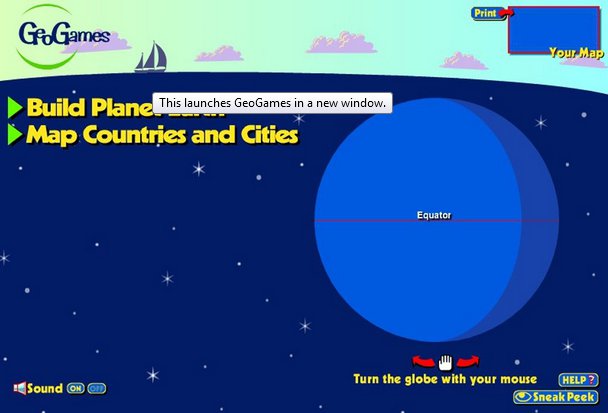EDUCATIONAL GAMES
Using interactive games to facilitate learning in educational settings has a number of recognized benefits. For most students, games are highly engaging and motivating. Games provide real-time feedback and built-in goals that can motivate students to improve. In addition, students must make decisions as they play games, and they can see the results of those decisions right away and use that information to inform their next decisions.
Meaningful games embed educational content and require students to engage in a variety of 21st century skills in order to be successful. These games compel students to apply a variety of knowledge, skills, and strategies to solve problems. Such games provide a rich environment that promotes collaboration, problem-solving, critical thinking, and communication.
Some of the games in this collection include companion educator guides for using game-play to explore specific subjects and topics with students.
source: http://nationalgeographic.org/education/games-and-interactives/
Build your own volcanoes using web page: http://discoverykids.com/games/volcano-explorer/
You can create different type of volcanoes and their varied eruptions.
You can make a geyser, set your own condition and then observe the results:
http://pbskids.org/fetch/games/geyser/game.html
Learn about rocks, minerals & soils as you complete a variety of interesting experiments with this fun, interactive activity. Rocks, minerals and soils have different characteristics that set them apart from others. Find out about the properties of rocks such as slate, marble, chalk, granite and pumice:
www.sciencekids.co.nz/gamesactivities/rockssoils.html
You don’t have to be a rocket scientist to launch a NASA spacecraft with NASA’s Rocket Science 101! Select your favorite NASA mission and build a rocket to send the spacecraft into orbit. As you take the RS101 challenge, you can learn more about thrilling missions and the various components of the launch vehicles, how they are configured and how they work together to successfully launch a NASA spacecraft. NASA’s Launch Services Program (LSP) does the same things for real rockets and exciting spacecraft missions every day – now it’s your turn!
This online simulator for events on the San Andreas Fault in California allows learners to explore the amount of energy released by an earthquake. Learners can manipulate the length and width of the fault and how much the fault slips. These variables, along with the rocks rigidity are used to calculate the Moment Magnitude of the fault. Students can use this simulator to explore just how big an earthquake might be possible on the San Andreas fault. This tool can be a useful to make comparisons when discussing disaster movies!
The game focuses on cognitive concepts, such as spatial relationships (where the continents are in relation to each other and to the oceans), nesting (how a city is a unit within a country, a country is a unit within a continent), and how countries, continents and oceans have vastly different sizes (scale.)
Designed to help educators teach and assess students’ geography mapping skills, GeoGames can be played as a group activity or individually. Each level of the game is graded easy, medium, or hard. Players can track and record their completion times using the automated game timer as well as print customized maps that reflect their progress at each level.










